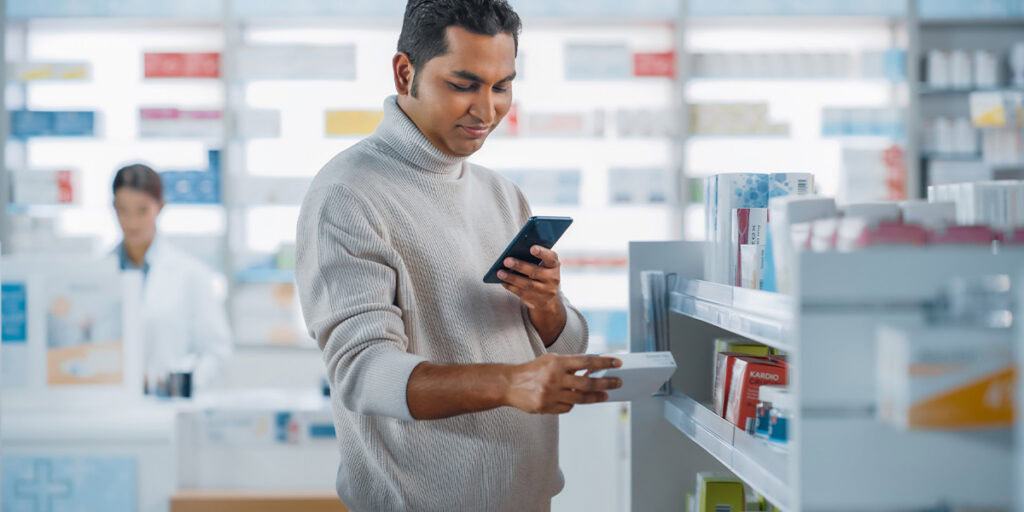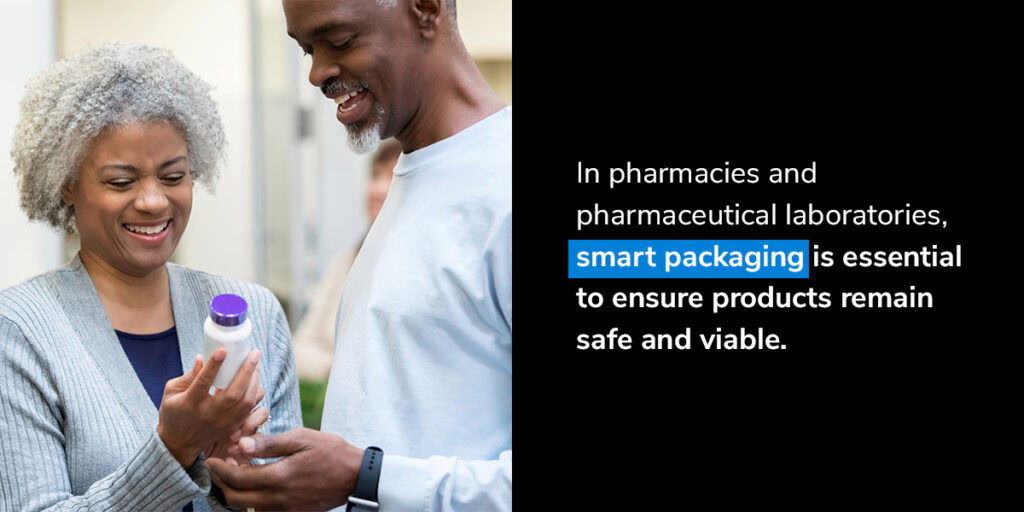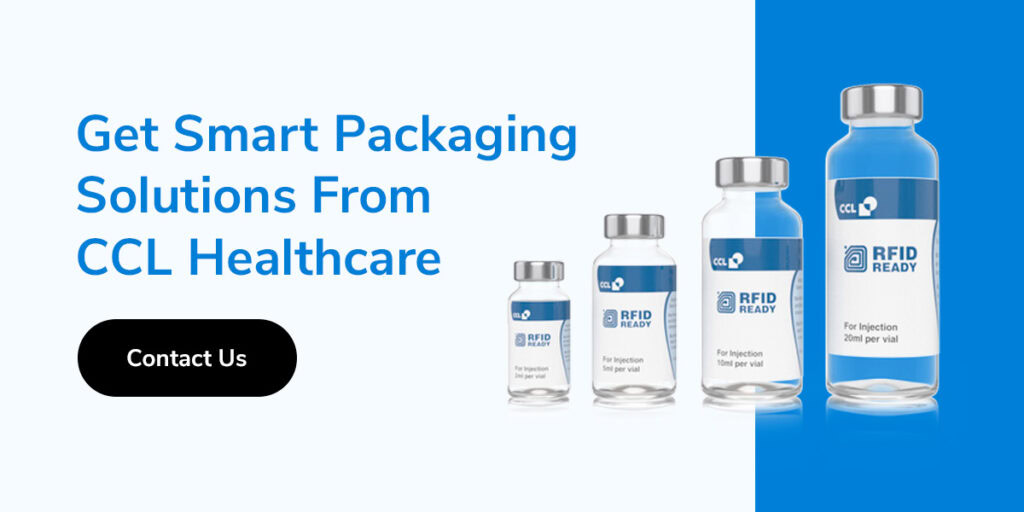
Technological advancements have fueled the emergence and growth of smart packaging, changing how products are manufactured and distributed. In particular, the pharmaceutical industry has adopted smart packaging in various ways. Smart packaging trends in the pharmaceutical industry reflect this adoption and continued improvements in smart technology, resulting in even better offerings to the end user.
Manufacturers and distributors of pharmaceutical products understand that safe packaging is essential. For the product to be effective, the consumer should receive it in perfect condition. Smart packaging enhances the utility of packaging.
Through the integration of science and technology, smart packaging brings digital solutions to improve the functionality and safety of the package and the products inside. Smart packaging technology helps the package do more than store or contain the product.
Generally, smart packaging can come in three different categories:
- Active packaging: This type of packaging allows for extended shelf life and quality control. It is important for product safety, quality assurance and efficacy.
- Intelligent packaging: This type of packaging encompasses technologies such as indicators, sensors and electronic components that provide real-time data about the product’s condition or environment.
- Connected packaging: This type of packaging integrates technologies such as radio frequency identification (RFID) tags, enabling interaction with the product.
Smart packaging technology is broad and covers different types of technologies integrated into packaging. Smart packaging companies continue to innovate and add new technologies that advance the usefulness of packaging. The following are some of the major trends in smart packaging for pharmaceuticals:
Smart Labels
Quick response (QR) codes are two-dimensional bar codes that store information. When scanned with a smart device, QR codes can enact a certain process, whether it’s directing the user to a specific website or starting a payment transaction.
In smart packaging for prescriptions, QR codes can take patients to specific digital content, such as instructional video content on how to use the medication. Patients can also use a QR code to check the product’s authenticity, manufacturing details and expiry date. Overall, companies can use QR codes to include more product information that couldn’t fit on the package.
Near field communication (NFC) tags are small chips that can be embedded into packaging to enable wireless communication with compatible devices, such as a mobile phone. Patients can access product information instantly by tapping their NFC-enabled smart device on the NFC-enabled packaging. Manufacturers use this technology for brand authentication and supply chain optimization.
RFID Technology
RFID tags are electronic devices that use radio waves for transmitting data to RFID readers. The tags have an antenna and microchip to store the tagged item’s information. One of the advantages of Ultra High Frequency (UHF) RFIDs is the ability to track items in real-time throughout the supply chain. They also feature anti-counterfeiting abilities and can be used for inventory management.
Temperature Monitoring
Time temperature indicators (TTIs) are smart devices that track thermal history. The devices visually indicate if a product has been exposed to temperatures beyond a specific threshold for a specific duration. The temperature indication helps establish whether the product is still safe for use.
In addition to TTIs, chemical indicator inks indicate whether certain conditions, such as chemical exposure or sterilization, have been met or exceeded. The ink undergoes visible changes when exposed to certain chemical conditions, such as pH, temperature or the presence of specific gases.
Tamper-Evident Packaging
TTIs and chemical indicators can be used for tamper-evident packaging, showing indicators that the packaging has already been opened. More specific tamper-evident packaging uses labels, closures and seals.
Companies invest in tamper-evident seals, serialization and holographic labels to protect products from unauthorized access, helping keep patients safe and increasing compliance with industry regulations and standards.
Microchips
Microchips or sensors are used to record data related to the product and packaging. Built-in sensors capture data from an activity involving the package or product and upload the data to a cloud source.
Smart packaging for pharmaceutical purposes offers various advantages, including:
1. Enhanced Medication Safety

Medication adherence can be a significant challenge, especially for older adults and chronically ill patients. In addition, many patients may not follow instructions correctly. Through technologies like NFC and RFID tags, patients can be reminded about their medications and dosages, helping them take their prescriptions as needed. Patients can also use QR codes to view information about medications and better understand how to administer them properly.
In pharmacies and pharmaceutical laboratories, smart packaging such as UHF and High Frequency (HF) is essential to ensure products remain safe and viable. For example, temperature indicators on packaging can help pharmacists understand if vaccines have experienced low temperature excursions. These labels allow you to quickly inspect each vial before use to ensure safety.
2. Enhanced Patient Experience
UHF RFID smart packaging technologies allow patients to have a more intuitive, user-friendly and personalized experience with their prescriptions. They can scan QR codes to access important information about their medications, such as side effects. Interactive packaging makes it easier for patients to understand their prescriptions and follow related directions.
3. Supply Chain Efficiency
Packaging tracking technology allows manufacturers and distributors to track pharmaceutical products to their destinations. Tracking can prevent the theft and tampering of the goods in transit. In addition, counterfeit prevention technologies ensure consumers receive authentic products — health care providers can quickly scan QR codes to ensure products are legitimate. Consumers can also use these technologies to confirm the product’s authenticity after receiving it.
4. Brand Differentiation
Pharmaceutical companies can stand out from their competitors by incorporating smart technologies in their packaging. This packaging creates a unique brand identity that consumers can easily identify. When consumers know their medications and other pharmaceutical products are safe and legitimate, and they can trace that authenticity back to your brand, you build loyalty and trust.
The global market size of smart packaging was estimated at $23.33 billion in 2023 and is projected to grow to $40.02 billion by 2032. The increasing demand for smart packaging technologies across sectors is fueling this growth. As this technology evolves, expectations for the future of smart packaging include:
- Innovative materials: Innovative materials will continue to be used in the production of packages, including compostable and biodegradable materials. More innovative options include materials with enhanced properties such as antimicrobial or oxygen scavenging capabilities. These materials have the combined benefits of being environmentally friendly and safe while improving functionality. Specifically, antimicrobial materials can prevent the growth of harmful bacteria in food products.
- Personalization and customization: Future smart technologies are expected to meet consumers’ demand for personalized products and experiences. Businesses can use technologies such as augmented reality and QR codes to provide their customers with personalized information and content through packaging. These technologies allow businesses to gather valuable insights and data about their customers’ behaviors and preferences. In addition, the technologies create a more engaging customer experience.
- Internet of Things (IoT): Although IoT technology is already in use, more advanced integration is expected in the future. Sensors and other technologies are integrated into packaging to provide real-time data on product conditions. IoT features can be used to provide consumers with information about the product’s origin and ingredients, monitor humidity and temperature levels, and track a product’s location during shipping.
- Sustainability and waste reduction: Companies can reduce their negative environmental impact by using biodegradable materials in smart packages. Active packaging that extends product shelf life can also help improve sustainability efforts.
Smart packaging extends the utility of packages and benefits the pharmaceutical companies and the patient — it’s a win-win. In addition, using smart packaging sets you apart from the competition and can help build your brand.
CCL Healthcare is a pharmaceutical smart packaging company that prioritizes patient safety above all else. As a global leader in the health care packaging industry, our mission is to deliver products of the utmost quality. We have a global footprint, providing extensive product offerings to businesses of all sizes, including 100% made-to-order options.
CCL Healthcare provides innovative solutions for the biotechnology, pharmaceutical, natural health and nutraceutical markets. Contact us for smart packaging solutions today!
